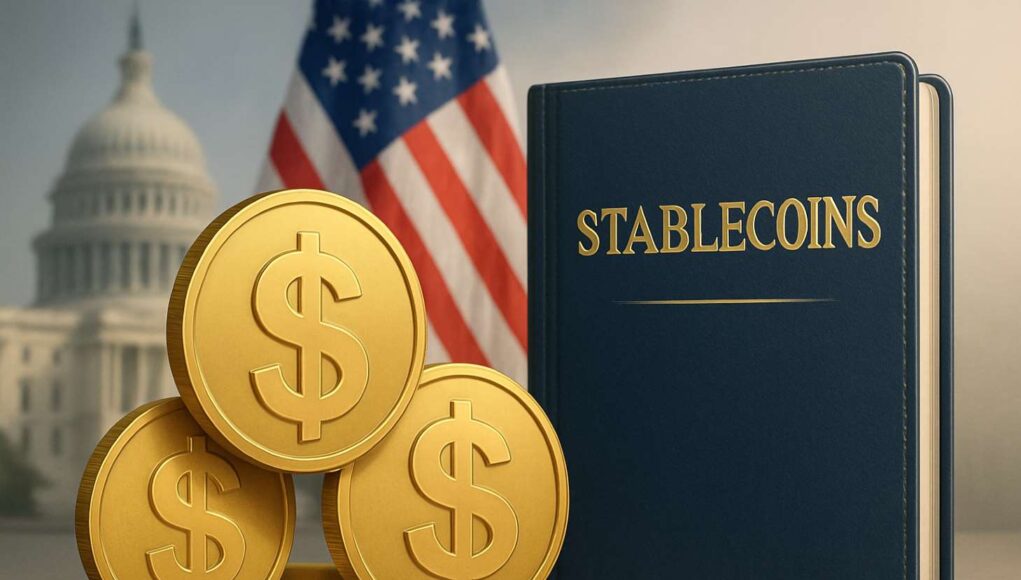The United States has taken a decisive step toward regulating digital finance with the signing of the first US stablecoin law, the GENIUS Act. This landmark legislation provides a comprehensive federal framework specifically targeting stablecoins, digital assets pegged to fiat currencies like the US dollar. The law now sets clear expectations for industry participants while introducing enhanced consumer safeguards.
As the crypto industry reacts to this sweeping regulatory shift, here’s what you need to know. We’ll cover the new compliance requirements, market implications, and what changes consumers can expect from new crypto-focused consumer protections.
Why This New US Stablecoin Law Matters
For years, the absence of unified federal guidelines created uncertainty for stablecoin issuers, investors, and consumers. Fragmented state-by-state policies offered little clarity on how stablecoins should operate, often leaving companies to navigate inconsistent oversight. As a result, it exposed consumers to unnecessary risk.
The GENIUS Act ends that uncertainty. By establishing a federal licensing regime and strict operational standards, the law aims to solidify the US position in the global digital finance landscape. It also helps ensure the dollar’s continued dominance in the digital economy.
Key Compliance Requirements for Stablecoin Issuers
Reserve Standards
One of the GENIUS Act’s most critical provisions mandates that all stablecoins must be backed on a 1:1 basis with cash or short-term US Treasuries. This ensures that every token issued can be redeemed for a dollar at any time, thus reducing the risk of sudden depegging events like the infamous Terra/UST collapse.
Segregated Reserves and Transparency
Issuers must maintain segregated reserves held with qualified custodians. They are required to provide monthly public disclosures of reserve holdings. Issuers must also submit to quarterly GAAP-compliant audits. These steps reinforce transparency and trust.
Compliance and Oversight
The law introduces clear stablecoin compliance requirements:
- Robust AML/KYC programs
- Reporting obligations to federal regulators
- Mandatory consumer protection disclosures
Issuers failing to meet these standards risk losing their operating licenses.
Restrictions on Big Tech and Financial Giants
The legislation includes explicit provisions aimed at preventing the concentration of power within a few dominant firms. Tech companies and major financial institutions cannot issue or integrate stablecoins within their platforms. They must create separate, non-leveraged subsidiaries subject to the same compliance rules. This “firewall” seeks to prevent any repeat attempts at global domination of digital money like Facebook’s failed Libra project.
What Consumers Should Expect from the New Law
Enhanced Protections
Consumers will benefit from clearer safeguards against fraud and instability. The new stablecoin law includes provisions to ensure that stablecoins operate with full backing, transparency, and oversight. These safeguards aim to protect consumers and enhance trust in digital finance. This gives users confidence their funds won’t disappear overnight.
Limitations on Yield Products
One notable restriction: stablecoin issuers are prohibited from offering yield or interest-bearing products directly. While this enhances safety, it also limits passive income opportunities for retail users. They will need to seek yield through separate, regulated investment platforms.
No FDIC Insurance
Despite these reforms, stablecoins remain outside traditional banking protections. Consumers should understand that while reserves are safer, these assets do not enjoy FDIC insurance guarantees.
Timeline for Implementation
Under the stablecoin regulation timeline:
- Regulatory agencies have 180 days to draft and publish detailed rules.
- Full compliance becomes mandatory 18 months after the law takes effect.
- Existing issuers have up to three years to transition or exit the market.
Broader Impact on the Crypto Industry
The US’s new stablecoin legislation is already influencing the markets. Crypto prices surged following the law’s passage. Institutional players are preparing to launch compliant stablecoins under the new framework. Analysts see the GENIUS Act as a milestone. It is expected to unlock new growth avenues in digital payments, remittances, and tokenized finance.
By reinforcing stablecoin security measures and creating pathways for regulated innovation, the US positions itself as a leader in shaping the future of digital finance. This move also aligns the US more closely with emerging global standards. Examples include the EU’s MiCA regulation and other frameworks across Asia.
>>> Read more: BITCOIN Act Approved, GENIUS Act Hits a Wall
Conclusion: A Safer, Clearer Future for Stablecoins
The US’s new stablecoin law, the GENIUS Act, marks a turning point for both industry participants and consumers. For issuers, the expectations around stablecoin compliance requirements are now crystal clear. For consumers, the law promises enhanced transparency and safeguards. However, it does not offer the high-yield opportunities some once associated with crypto’s Wild West days.
While debates over innovation versus regulation will continue, one thing is certain. Stablecoins now operate under the watchful eye of Washington. The era of unchecked issuance is officially over.
Readers’ frequently asked questions
How does this law affect foreign stablecoin issuers?
Foreign issuers who want to offer stablecoins to US consumers will need to comply with compatibility standards outlined by US regulators. Although there are exemptions available, these are conditional on meeting equivalent regulatory standards abroad. In practice, most major foreign issuers will need to align with US rules or risk exclusion from the American market.
Are stablecoins under this law insured like bank deposits?
No. Stablecoins, even under this law, do not receive FDIC insurance or similar guarantees. Although the law strengthens reserve and transparency requirements, consumers should understand that stablecoins remain distinct from traditional bank accounts in terms of legal protections.
What impact does this have on DeFi and non-custodial wallets?
The law primarily targets fiat-backed stablecoin issuers and does not directly regulate decentralized finance (DeFi) platforms or non-custodial wallets. However, stablecoins issued under these new rules may face limitations on how they can be used in DeFi protocols, especially if those protocols operate without regulatory oversight. Over time, this could push DeFi platforms to clarify their legal standing or risk losing access to compliant stablecoin liquidity.
What is in it for you? Action items you might want to consider
Track stablecoin regulatory compliance developments
Monitor updates from US regulators as they draft implementation rules over the next 180 days. These will clarify the operational details that banks, fintechs, and foreign issuers must follow.
Assess stablecoin issuer readiness and partnerships
If you work in finance, payments, or crypto, evaluate how your partners or providers are aligning with the new licensing, reserve, and audit standards. Consider reassessing integrations with any issuer that lacks a clear path to compliance.
Evaluate DeFi implications and usage risks
Watch how DeFi protocols respond to these regulatory changes. Legal clarity may increase reliance on US-compliant stablecoins, but some DeFi services may face liquidity risks or new regulatory pressures as a result.











[…] limited checkout features, launched its own PYUSD stablecoin, and quietly secured partnerships and regulatory clarity. Now, with “Pay with Crypto” fully activated for U.S. merchants, PayPal’s multi-year crypto […]
[…] Resolving this lawsuit saves time and resources, and it offers finality before upcoming stablecoin legislation and licensing frameworks take […]
[…] doesn’t eliminate human error; it scales it faster. Strong stablecoin governance remains the only counterweight to algorithmic […]
[…] The Western Union USDPT stablecoin will be fully backed one-to-one with U.S. dollars held in regulated accounts. It will be issued under the supervision of Anchorage Digital Bank. Each token will be redeemable for dollars, ensuring compliance with the GENIUS Act and other stablecoin oversight rules. […]
[…] >>> Read more: US Stablecoin Law 2025: Key Changes for Compliance and DeFi […]
[…] second driver behind this structural shift is regulation. Frameworks like MiCA in Europe, the upcoming U.S. stablecoin bill, and new Asian licensing regimes are giving legitimacy to stablecoins while hardwiring them into […]
[…] years. New market structure legislation is expected, and stablecoin rules have advanced through the GENIUS Act’s stablecoin framework. For the first time since 2021, major crypto companies see a path toward predictable, functional US […]